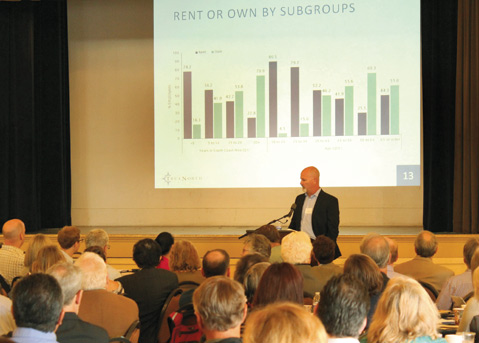The South Coast: A Tale of Two Workforces
Grim Facts Revealed About Housing/Jobs Imbalance

The picture painted by this year’s Santa Barbara Housing Conference was bleak. Not only does the South Coast rank in the top 25 least affordable places to live nationwide, local employers struggle to recruit and retain quality workers as they’re priced out of an impenetrably expensive market. Equally, commuters from North County and Ventura suffer highway traffic, family stress, and lower productivity.
The Coastal Housing Coalition hosted its annual confab last Friday, and it commissioned a report that found more than 70 percent of South Coast employees can’t afford to purchase a home in the region; 44 percent have considered leaving in order to live and work in an area with more affordable housing.
The region’s jobs/housing imbalance, said researcher Dr. Tim McLarney, disproportionately affects those who entered the South Coast job market after the housing boom 15 years ago. “It’s really a tale of two workforces,” he said, explaining those who’ve worked here longer are much more likely to own property — 60 percent versus 30 percent — live in the most desirable single-family units, reside in good school districts, and paid fairer prices.
On the other hand, the 3,000 employees McLarney polled — 94 percent of whom are college graduates — are often stuck in rentals they’re not satisfied with and think they pay too much for. They make up 58 percent of the workforce, and that percentage is steadily increasing as older employees retire, he said.
The implication is that area employers, the tax base for public services and the entire South Coast economy, will become more and more dependent on the talent and skills of employees who entered the job market post-2000. Yet only around one in five can afford to own a home nearby, McLarney said, calling the disparity “stark” compared to other Southern California regions he’s studied. When he asked employees if they’d be interested in renting or owning workforce housing in the area — not for low-income individuals but “certainly a lot cheaper than what’s on the market now,” McLarney said—over half of the respondents liked the idea.
Nearly 75 percent of employers said the biggest challenge to doing business on the South Coast is the real estate market and/or the cost of living; 34 percent said they don’t recruit from outside the area, because relocation is too expensive. Fifty-six percent of business owners said lack of available housing reduces their company’s profits, and 10 percent said they’ve considered moving their business out of the South Coast. McLarney polled 126 companies, large and small, old and new. Read the full report here.
Ann Peak with the Santa Barbara Unified School District’s Human Resources Department said the effect of the housing market on hiring and keeping good teachers has been “huge.” The district had to recruit more than 100 teachers last year after a number of retirements, Peak said, but while many of the new hires jumped at the opportunity, they often called a week or two before their start dates to say they couldn’t find an affordable place to live. So the district brought in substitute teachers. “The kids are definitely impacted,” Peak said.
The situation will only get worse in the next 5-10 years if things don’t start to change fast, she went on. The district will become populated with less-experienced educators, as those who can afford to stay in Santa Barbara are often recent college graduates content living with roommates.
Reyne Stapelmann, a broker with Berkshire Hathaway, said the realty company has only 345 properties on its books. “There’s so little inventory,” she complained, noting how bidding wars for such reduced stock often push prices of already expensive homes even higher. Less often do seniors sell their houses and move to condos or retirement homes, she said, and that keeps the spaces out of the hands of young professionals and families looking to upgrade. “It’s very frustrating for buyers,” she summed up.
As city and county planners gave brief overviews of how their respective jurisdictions are trying to encourage development without injuring the South Coast’s way of life, a number of different speakers presented other solutions to the housing problem, including creating more workforce housing, streamlining permit and approval processes, cracking down on vacation rentals, revisiting height limitations, encouraging denser growth, and examining community land trusts.



